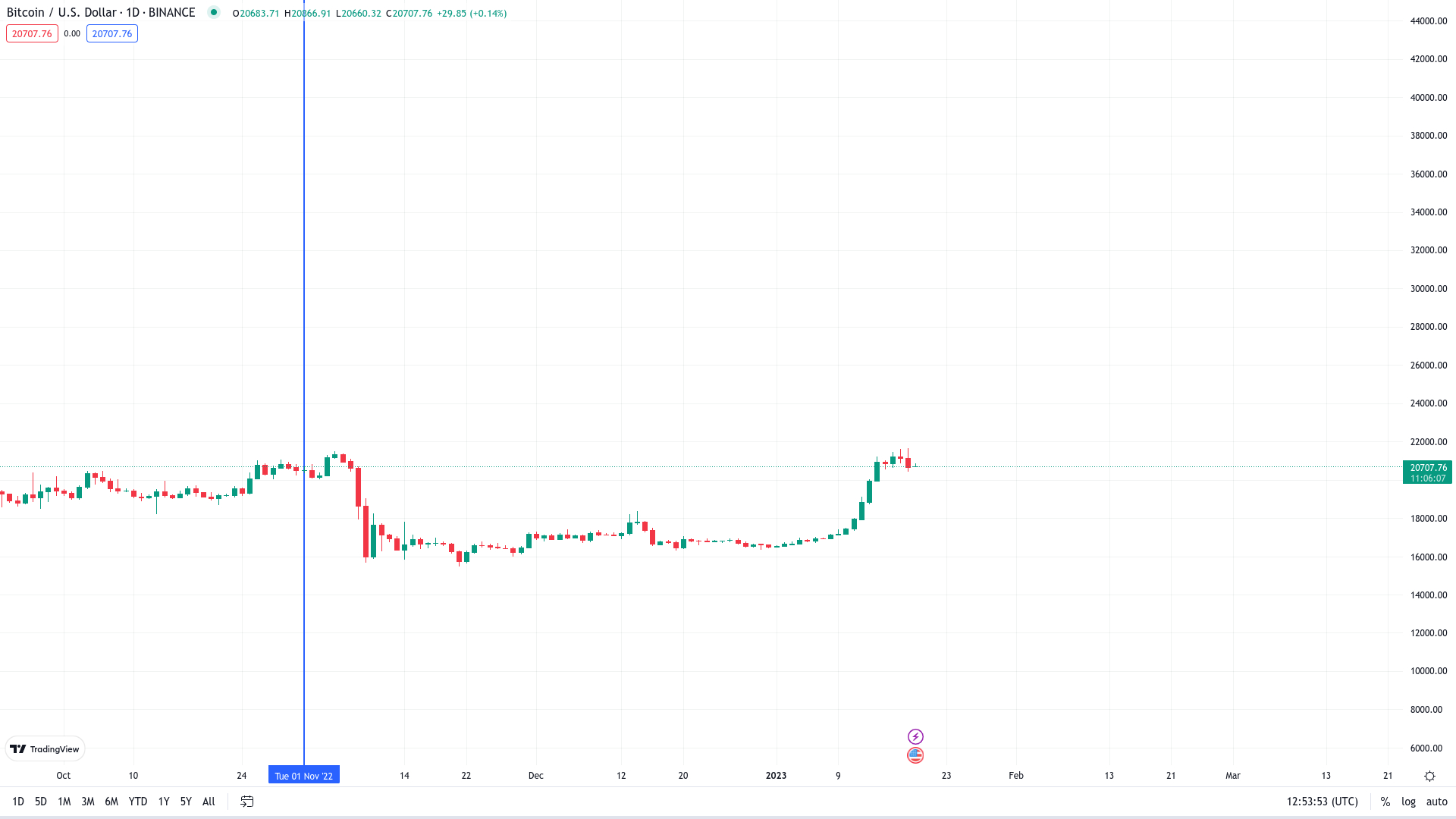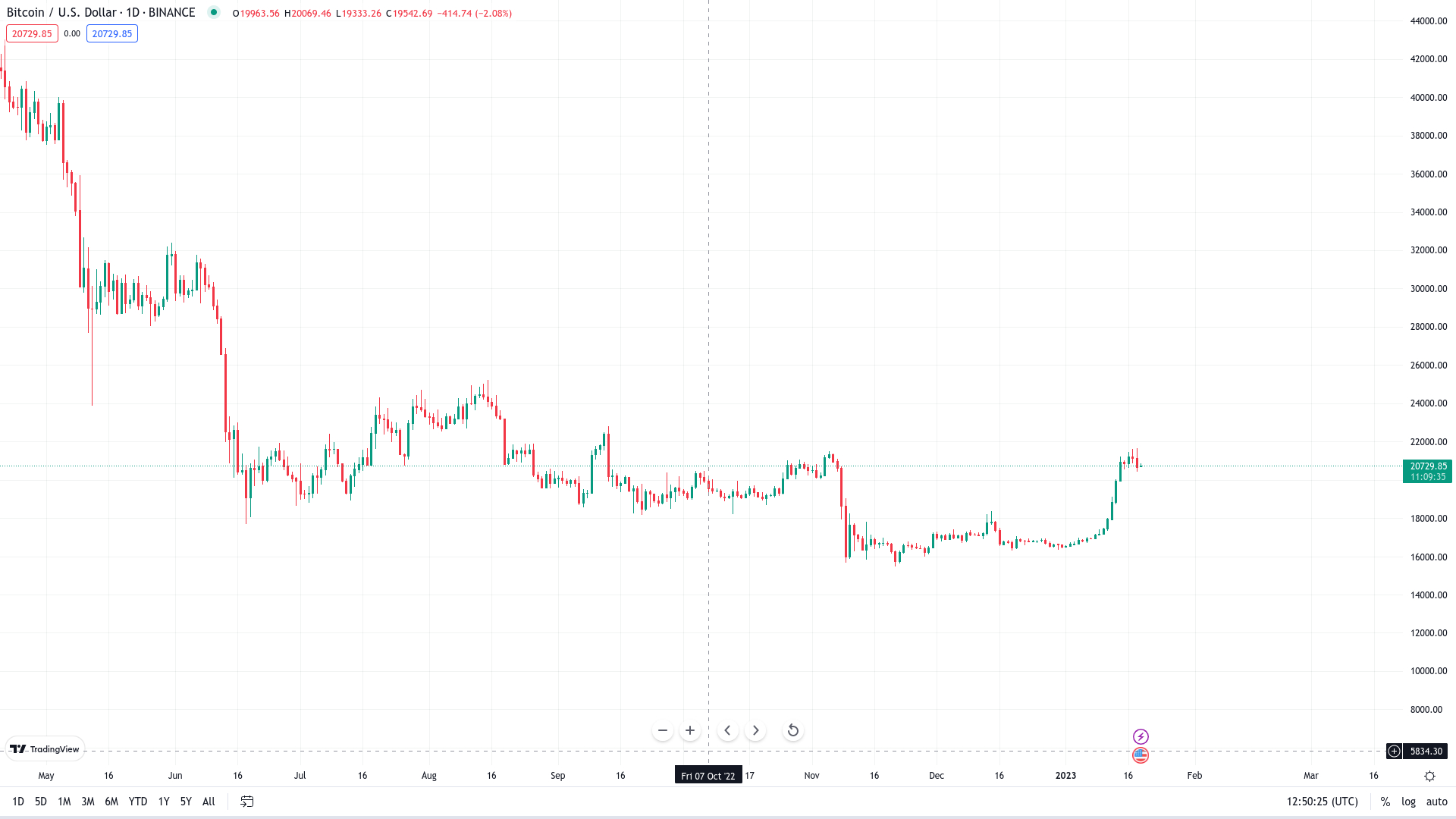[ad_1]
The beginning of 2023 has seen Bitcoin regain some of its old fervour and pull itself up above the $20,000 mark for the first time since early November. The big question, however, is why?
The marketplace is no more rosy now than it was then, with exchange crashes and stories of fraud aplenty. And Bitcoin’s much-heralded safe haven characteristic – the ‘digital gold’ – as it once was called, has never truly come to pass. On top of that, inflation and high interest rates mean we all have less disposable income than we did this time last year and during the pandemic, and investing for a brighter tomorrow is no longer a top priority. So, what’s going on?
A popular myth when it comes to investing is that of supply and demand. The theory is that when something is lacking, it becomes more expensive and sought after, and when it is in abundance, it becomes cheaper and less interesting. Sounds logical, huh. Works for bananas, petrol, house prices. But does it work for Bitcoins? Not really.
There are more Bitcoins being added to the overall supply each day, that is true, and at an ever-decreasing rate as we approach the magical 21 million mark, but that’s still a long way off. And we are all fairly confident that few people are running out and buying Bitcoins right now as they have been lacklustre for quite a while and showing few signs of going anywhere near their high of November 2020.
So, if they are not becoming super scarce all of a sudden, and nobody is really buying them, what’s going on?
Two words: Big Money
Big Money is the catch-all name given to banks, financial institutions, insurance companies, pension funds, etc, who have billions upon billions to invest. These control money markets. Full Stop. Even with all the retail investors (like you and me) clubbed together, it only amounts to around 20% of the amount of investing that goes on in the world. The rest is Big Money.
So what does that actually mean? It means, we don’t mean anything in the grand scheme of things. Were we all to stop investing tomorrow and keep our money under our matresses, it would make virtually no difference at all. Sounds nihilistic, I know, but it is just the way it is.
So what we can as the ‘little people’ do? Quite simply, we follow Big Money.
If Bitcoin’s price is going up, it’s because Big Money wants it to. Currency price movements are not inexplicably oscillating candles on a chart. There are incredibly powerful algorithms at work, making sure everyone gets their share, and that everyone is satisfied. Take a moment to think about it: Does it seem at all plausible that the central banks around the world blindly follow a line on a chart, hoping and praying that it doesn’t go the wrong way and bring their country down? Of course not. Algorithms are in place to keep things on an even keel. Take at look at this Bitcoin chart:

It shows Bitcoin’s price movements back to May of 2022. What do we see? Well, a downtrend. The price is lower now than it was then, so a downtrend. Now look at the price movements in November:

There was a sharp drop early in the month as news of the FTX collapse broke. Yes, major news events can defeat the algorithm. Events like this, or earthquakes, monetary policy changes, etc., yes. But otherwise it is in control. How do we know that? Look at the rest of the month, and up until the end of December. What do we see? Nothing. Zilch. Nada. Alameda owes billions, thousands of investors out of pocket, Genesis on the brink of bankruptcy. Nothing. Zilch. Nada. Why? Because all of that makes virtually no difference. Bitcoin’s market cap is just under $300 billion. There is simply not enough combined force with all of those events to make any difference. And how do we know that? Because the price has gone back up.
Now, a retail trader or a crypto investment brokerage will paint that chart with RSIs and moving averages and MACDs and trend lines and other magical and mystical indicators that will enable them to say they knew this was coming all along, and not only that, that this is just the beginning. And you’ll believe it, because it all seems really logical. Lines going up = price is going up, and continuing to go up. Unfortunately, that’s not how it works.
Indicators merely try to make sense of what we are seeing. By analogy, if we watch the sun move across the sky, we think it is moving around us, because we are standing still. We know that is not true, and neither are weird and wonderful indicators that predict fame and fortune. Let’s take another look at that chart, but now imagine you are a financial institution. What do you see? (Hint: remember everyone gets their share and everyone is satisfied).

To put you out of your misery: we see buyers getting their day in the sun. Prices move from lows to highs – simple as that. The last high was in early November. The price fell sharply, giving buyers no chance to fill their orders, and since then they have been waiting, and now it’s their turn. Look at the current price. It is virtually at the same level of that past high. Everyone gets their share, and everyone is satisfied.
So, what happens next? Good question. Price moves to highs and lows. Why? Because that’s where the money is. Big Money doesn’t follow indicators or anything like that. It places buy and sell orders at prices it is willing to pay, and waits. When the price hits those orders, they are triggered, and the deal goes through, putting liquidity into the market. The market uses that liquidity to keep itself going, like fuel.
So again, what happens next? Let’s have a look at our first chart again, now with our Big Money glasses on:

So, the Early November highs have been swept, and the sell orders waiting there have been triggered. The lowest we have been since then was on 21 November, when we touched $15,479. The last high prior to the Early November peak was on 13 September, when we touched $22,801. Big Money has buy orders waiting below that low, and sell orders waiting above that high. All that white space on the chart is not space. It is money, and lots of it, just waiting to be tapped into.
So, for a third and final time, what happens next??? Moments like this are tough to predict. As price moves towards a past low or high, we can make high probability decisions that price will continue to that high or low and sweep the orders waiting there, but when it actually reaches it, we need to wait and see where it will go next. Will it now continue upwards towards the 13 September high and the sell orders waiting there, or down to the 21 November low to snatch the buy orders there? The algorithm knows, so watch what it does…
[ad_2]
cryptonews.com




